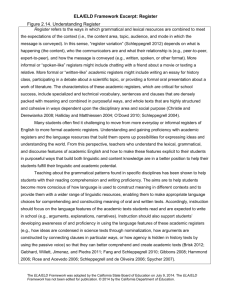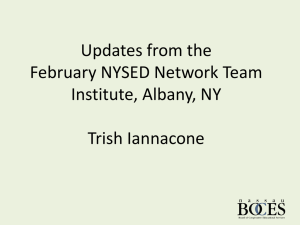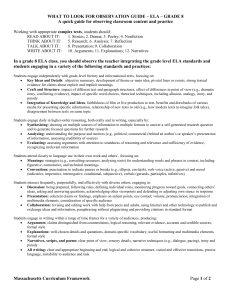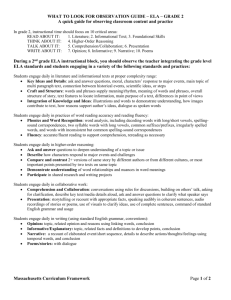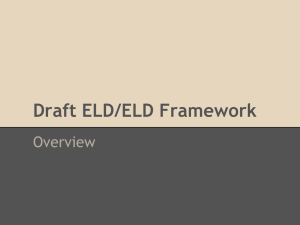Extended Phrases Examples
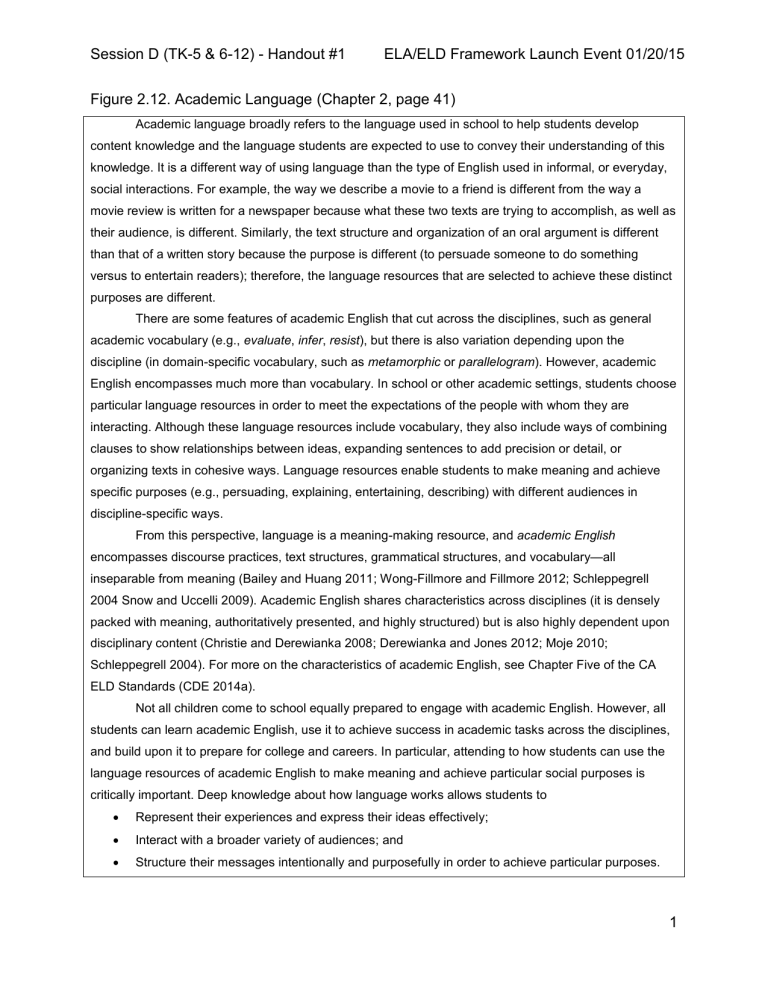
Session D (TK-5 & 6-12) - Handout #1 ELA/ELD Framework Launch Event 01/20/15
Figure 2.12. Academic Language (Chapter 2, page 41)
Academic language broadly refers to the language used in school to help students develop content knowledge and the language students are expected to use to convey their understanding of this knowledge. It is a different way of using language than the type of English used in informal, or everyday, social interactions. For example, the way we describe a movie to a friend is different from the way a movie review is written for a newspaper because what these two texts are trying to accomplish, as well as their audience, is different. Similarly, the text structure and organization of an oral argument is different than that of a written story because the purpose is different (to persuade someone to do something versus to entertain readers); therefore, the language resources that are selected to achieve these distinct purposes are different.
There are some features of academic English that cut across the disciplines, such as general academic vocabulary (e.g., evaluate , infer , resist ), but there is also variation depending upon the discipline (in domain-specific vocabulary, such as metamorphic or parallelogram ). However, academic
English encompasses much more than vocabulary. In school or other academic settings, students choose particular language resources in order to meet the expectations of the people with whom they are interacting. Although these language resources include vocabulary, they also include ways of combining clauses to show relationships between ideas, expanding sentences to add precision or detail, or organizing texts in cohesive ways. Language resources enable students to make meaning and achieve specific purposes (e.g., persuading, explaining, entertaining, describing) with different audiences in discipline-specific ways.
From this perspective, language is a meaning-making resource, and academic English encompasses discourse practices, text structures, grammatical structures, and vocabulary —all inseparable from meaning (Bailey and Huang 2011; Wong-Fillmore and Fillmore 2012; Schleppegrell
2004 Snow and Uccelli 2009). Academic English shares characteristics across disciplines (it is densely packed with meaning, authoritatively presented, and highly structured) but is also highly dependent upon disciplinary content (Christie and Derewianka 2008; Derewianka and Jones 2012; Moje 2010;
Schleppegrell 2004). For more on the characteristics of academic English, see Chapter Five of the CA
ELD Standards (CDE 2014a).
Not all children come to school equally prepared to engage with academic English. However, all students can learn academic English, use it to achieve success in academic tasks across the disciplines, and build upon it to prepare for college and careers. In particular, attending to how students can use the language resources of academic English to make meaning and achieve particular social purposes is critically important. Deep knowledge about how language works allows students to
Represent their experiences and express their ideas effectively;
Interact with a broader variety of audiences; and
Structure their messages intentionally and purposefully in order to achieve particular purposes.
1
Session D (TK-5 & 6-12) - Handout #1 ELA/ELD Framework Launch Event 01/20/15
Figure 2.13. Categories of Vocabulary (Chapter 2, page 44)
Vocabulary
Conversational
(Tier One)
General Academic
Definition
Words of everyday use
(Tier Two)
Words that are far more likely to appear in text than in everyday use, are highly generalizable because they appear in many types of texts, and often represent precise or nuanced meanings of relatively common things
Examples happy, dog, run, family, boy, play, water develop, technique, disrupt, fortunate, frightening, enormous, startling strolled, essential
Domain-Specific
(Tier Three)
Words that are specific to a domain or field of study and key to understanding a new concept equation, place value, germ, improvisation, tempo, percussion, landform, thermometer
Figure 2.14. Understanding Register (Chapter 2, pages 45-46)
Register refers to the ways in which grammatical and lexical resources are combined to meet the expectations of the context (i.e., the content area, topic, audience, and mode in which the message is conveyed). In this sense, “register variation” (Schleppegrell 2012) depends on what is happening (the content), who the communicators are and what their relationship is (e.g., peer-to-peer, expert-to-peer), and how the message is conveyed (e.g., written, spoken, or other format). More informal or “spoken-like” r egisters might include chatting with a friend about a movie or texting a relative. More formal or “writtenlike” academic registers might include writing an essay for history class, participating in a debate about a scientific topic, or providing a formal oral presentation about a work of literature. The characteristics of these academic registers, which are critical for school success, include specialized and technical vocabulary, sentences and clauses that are densely packed with meaning and combined in purposeful ways, and whole texts that are highly structured and cohesive in ways dependent upon the disciplinary area and social purpose (Christie and Derewianka 2008; Halliday and Matthiessen 2004; O’Dowd 2010;
Schleppegrell 2004).
Many students often find it challenging to move from more everyday or informal registers of
English to more formal academic registers. Understanding and gaining proficiency with academic registers and the language resources that build them opens up possibilities for expressing ideas and understanding the world. From this perspective, teachers who understand the lexical, grammatical, and
2
Session D (TK-5 & 6-12) - Handout #1 ELA/ELD Framework Launch Event 01/20/15 discourse features of academic English and how to make these features explicit to their students in purposeful ways that build both linguistic and content knowledge are in a better position to help their students fulfill their linguistic and academic potential.
Teaching about the grammatical patterns found in specific disciplines has been shown to help students with their reading comprehension and writing proficiency. The aims are to help students become more conscious of how language is used to construct meaning in different contexts and to provide them with a wider range of linguistic resources, enabling them to make appropriate language choices for comprehending and constructing meaning of oral and written texts. Accordingly, instruction should focus on the language features of the academic texts students read and are expected to write in school (e.g., arguments, explanations, narratives). Instruction should also support students’ developing awareness of and proficiency in using the language features of these academic registers (e.g., how ideas are condensed in science texts through nominalization, how arguments are constructed by connecting clauses in particular ways, or how agency is hidden in history texts by using the passive voice) so that they can better comprehend and create academic texts (Brisk 2012; Gebhard, Willett, Jimenez, and
Piedra 2011; Fang and Schleppegrell 2010; Gibbons 2008; Hammond 2006; Rose and Acevedo 2006;
Schleppegrell and de Oliveira 2006; Spycher 2007).
Figure 2.15. Structures for Engaging All Students in Academic Conversations (Chapter
2, pages 49-50)
Rather than posing a question and taking immediate responses from a few students, teachers can employ more participatory and collaborative approaches such as those that follow. Teachers can also ensure that students interact with a range of peers. For each of the illustrative examples provided here, teachers should emphasize extended discourse, that is, multiple exchanges between students in which they engage in rich dialogue. It is also important that teachers select approaches that support the needs of students and encourage diverse types of interaction.
Think-Pair-Share
A question is posed and children are given time to think individually. Then each student expresses his or her thoughts and responds to a partner, asking clarifying questions, adding on, and so forth. The conversation is often expanded to a whole-class discussion. (Lyman 1981)
Think-Write-Pair-Share
Students respond to a prompt or question by first thinking independently about their response, then writing their response. They then share their thoughts with a peer. The conversation is often expanded to a whole-group discussion.
Quick Write/Quick Draw
Students respond to a question by quickly writing a few notes or rendering a drawing (e.g., a sketch of the water cycle) before being asked to share their thinking with classmates.
3
Session D (TK-5 & 6-12) - Handout #1 ELA/ELD Framework Launch Event 01/20/15
Literature/Learning Circles
Students take on various roles in preparation for a small-group discussion. For example, as they listen to, view, or read a text, one student attends to and prepares to talk about key vocabulary, another student prepares to discuss diagrams in the text, and a third student poses questions to the group. When they meet, each student has a turn to share and others are expected to respond by asking clarifying questions as needed and reacting to and building on the comments of the student who is sharing. (Daniels 1994)
Inside-Outside Circles
Students think about and mentally prepare a response to a prompt such as What do you think was the author’s message in the story? or Be ready to tell a partner something you found interesting in this unit of study. Students form two circles, one inside the other. Students face a peer in the opposite circle. This peer is the person with whom they share their response. After brief conversations, students in one circle move one or more peers to their right in order to have a new partner, thus giving them the opportunity to articulate their thinking again and to hear a new perspective. (Kagan 1994)
The Discussion Web
Students discuss a debatable topic incorporating listening, speaking, reading, and writing. Students are given content-based reading, a focusing question, and clear directions and scaffolds for developing arguments supporting both sides of the question (Alvermann 1991; Buehl 2009).
Expert Group Jigsaw
Students read a text and take notes, then work together in small (3-5 students) expert groups with other students who read the same text to compare notes and engage in an extended discussion about the reading. They come to a consensus on the most important things to share with others who did not read the same text. Then, they convene in small “jigsaw groups” to share about what they read and to gather information about what others read. Finally, the expert groups reconvene to compare notes on what they learned.
Structured Academic Controversy
Like the Discussion Web, Structured Academic Controversy is a cooperative approach to conversation in which small teams of students learn about a controversial issue from multiple perspectives. Students work in pairs, analyzing texts to identify the most salient parts of the argument from one perspective. Pairs present their arguments to another set of partners, debate the points, and then switch sides, debating a second time. Finally, the students aim to come to consensus through a discussion of the strengths and weaknesses of both sides of the argument (Johnson and Johnson 1999).
Opinion Formation Cards
Students build up their opinion on a topic as they listen to the ideas of others. Students have “evidence cards”—small cards with different points of evidence drawn from a text or texts. Students meet with other students who have different points of evidence, read the points to each other, state their current opinions, ask questions, and prompt for elaboration (Zwiers, O’Hara, and Pritchard 2014).
4
Session D (TK-5 & 6-12) - Handout #1 ELA/ELD Framework Launch Event 01/20/15
Socratic Seminar
Students engage in a formal discussion based on a text where the leader asks open-ended questions.
The teacher facilitates the discussion as students listen closely to the comments of others, asking questions, articulating their own thoughts, and building on the thoughts of others (Israel 2002).
Philosopher’s Chair, Strategic Collaborative Instruction, Constructive Conversations, and Argument
Balance Scales are examples of other strategies, and there are many others.
5
Session D (TK-5 & 6-12) - Handout #1 ELA/ELD Framework Launch Event 01/20/15
Nominalization Examples
Verb develop grow vibrate interact judge
Invest
Noun development growth vibration interaction judgment investment
1. The development of the ELD Standards will require extensive interaction activities (We need to develop more opportunities for students to interact).
2. The interaction of positive and negative charges is observable. (You can observe how charges interact with each other).
Extended Phrases Examples
Noun phrases
The green, scary bumpy alligator in the slimy swamp is sleeping.
Adverb clauses
Although the cake looked delicious, I dared not take a bite.
When she grinned, her baby teeth shone like a string of pearls, and when she laughed her shoulders shook and twitched.
6
